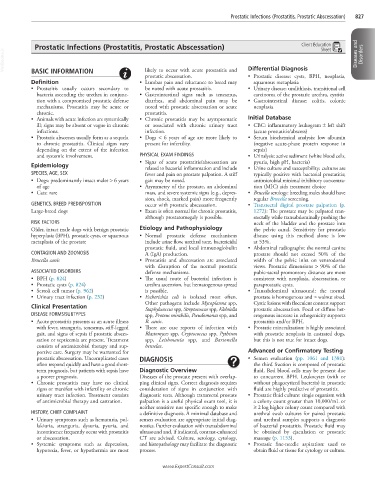Page 1642 - Cote clinical veterinary advisor dogs and cats 4th
P. 1642
Prostatic Infections (Prostatitis, Prostatic Abscessation) 827
Prostatic Infections (Prostatitis, Prostatic Abscessation) Client Education
Sheet
VetBooks.ir Differential Diagnosis Diseases and Disorders
likely to occur with acute prostatitis and
BASIC INFORMATION
prostatic abscessation. • Prostatic disease: cysts, BPH, neoplasia,
Definition • Lumbar pain and reluctance to breed may squamous metaplasia
• Prostatitis usually occurs secondary to be noted with acute prostatitis. • Urinary disease: urolithiasis, transitional cell
bacteria ascending the urethra in conjunc- • Gastrointestinal signs such as tenesmus, carcinoma of the prostatic urethra, cystitis
tion with a compromised prostatic defense diarrhea, and abdominal pain may be • Gastrointestinal disease: colitis, colonic
mechanisms. Prostatitis may be acute or noted with prostatic abscessation or acute neoplasia
chronic. prostatitis.
• Animals with acute infection are systemically • Chronic prostatitis may be asymptomatic Initial Database
ill; signs may be absent or vague in chronic or associated with chronic urinary tract • CBC: inflammatory leukogram ± left shift
infections. infection. (acute prostatitis/abscess)
• Prostatic abscesses usually form as a sequela • Dogs < 6 years of age are more likely to • Serum biochemical analysis: low albumin
to chronic prostatitis. Clinical signs vary present for infertility. (negative acute-phase protein response in
depending on the extent of the infection sepsis)
and systemic involvement. PHYSICAL EXAM FINDINGS • Urinalysis: active sediment (white blood cells,
• Signs of acute prostatitis/abscessation are pyuria, high pH, bacteria)
Epidemiology related to bacterial inflammation and include • Urine culture and susceptibility: cultures are
SPECIES, AGE, SEX fever and pain on prostate palpation. A stiff typically positive with bacterial prostatitis;
• Dogs: predominantly intact males > 6 years gait may be noted. antimicrobial minimal inhibitory concentra-
of age • Asymmetry of the prostate, an abdominal tion (MIC) aids treatment choice
• Cats: rare mass, and severe systemic signs (e.g., depres- • Brucella serology: breeding males should have
sion, shock, marked pain) more frequently regular Brucella screening.
GENETICS, BREED PREDISPOSITION occur with prostatic abscessation. • Transrectal digital prostate palpation (p.
Large-breed dogs • Exam is often normal for chronic prostatitis, 1272): The prostate may be palpated tran-
although prostatomegaly is possible. srectally while transabdominally pushing the
RISK FACTORS neck of the bladder and the prostate into
Older, intact male dogs with benign prostatic Etiology and Pathophysiology the pelvic canal. Sensitivity for prostatic
hyperplasia (BPH), prostatic cysts, or squamous • Normal prostatic defense mechanisms disease using this method alone is low
metaplasia of the prostate include urine flow, urethral tone, bactericidal at 53%.
prostatic fluid, and local immunoglobulin • Abdominal radiographs: the normal canine
CONTAGION AND ZOONOSIS A (IgA) production. prostate should not exceed 50% of the
Brucella canis • Prostatitis and abscessation are associated width of the pelvic inlet on ventrodorsal
with disruption of the normal prostatic views. Prostatic dimensions > 90% of the
ASSOCIATED DISORDERS defense mechanisms. pubic-sacral promontory distance are more
• BPH (p. 824) • The usual route of bacterial infection is consistent with neoplasia, abscessation, or
• Prostatic cysts (p. 824) urethra ascension, but hematogenous spread paraprostatic cysts.
• Sertoli cell tumor (p. 962) is possible. • Transabdominal ultrasound: the normal
• Urinary tract infection (p. 232) • Escherichia coli is isolated most often. prostate is homogenous and ≈ walnut sized.
Other pathogens include Mycoplasma spp, Cystic lesions with flocculent content support
Clinical Presentation Staphylococcus spp, Streptococcus spp, Klebsiella prostatic abscessation. Focal or diffuse het-
DISEASE FORMS/SUBTYPES spp, Proteus mirabilis, Pseudomonas spp, and erogenous increase in echogenicity supports
• Acute prostatitis presents as an acute illness B. canis. prostatitis and/or BPH.
with fever, stranguria, tenesmus, stiff-legged • There are case reports of infection with • Prostatic mineralization: is highly associated
gait, and signs of sepsis if prostatic absces- Blastomyces spp, Cryptococcus spp, Pythium with prostatic neoplasia in castrated dogs,
sation or septicemia are present. Treatment spp, Leishmania spp, and Bartonella but this is not true for intact dogs.
consists of antimicrobial therapy and sup- henselae.
portive care. Surgery may be warranted for Advanced or Confirmatory Testing
prostatic abscessation. Uncomplicated cases DIAGNOSIS • Semen evaluation (pp. 1061 and 1381):
often respond quickly and have a good short- the third fraction is composed of prostatic
term prognosis, but patients with sepsis have Diagnostic Overview fluid. Red blood cells may be present due
a poorer prognosis. Diseases of the prostate present with overlap- to concurrent BPH. Leukocytes (with or
• Chronic prostatitis may have no clinical ping clinical signs. Correct diagnosis requires without phagocytized bacteria) in prostatic
signs or manifest with infertility or chronic consideration of signs in conjunction with fluid are highly predictive of prostatitis.
urinary tract infection. Treatment consists diagnostic tests. Although transrectal prostate • Prostatic fluid culture: single organism with
of antimicrobial therapy and castration. palpation is a useful physical exam tool, it is a colony count greater than 10,000/mL or
neither sensitive nor specific enough to make ≥ 2 log higher colony count compared with
HISTORY, CHIEF COMPLAINT a definitive diagnosis. A minimal database and urethral swab cultures for paired prostatic
• Urinary symptoms such as hematuria, pol- semen evaluation are appropriate initial diag- and urethral samples supports a diagnosis
lakiuria, stranguria, dysuria, pyuria, and nostics. Further evaluation with transabdominal of bacterial prostatitis. Prostatic fluid may
incontinence frequently occur with prostatitis ultrasound and, if indicated, contrast-enhanced be obtained by ejaculation or prostatic
or abscessation. CT are advised. Culture, serology, cytology, massage (p. 1153).
• Systemic symptoms such as depression, and histopathology may facilitate the diagnostic • Prostatic fine-needle aspiration: used to
hyporexia, fever, or hypothermia are most process. obtain fluid or tissue for cytology or culture.
www.ExpertConsult.com

